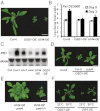Perturbation of cell cycle regulation triggers plant immune response via activation of disease resistance genes
- PMID: 23345424
- PMCID: PMC3568333
- DOI: 10.1073/pnas.1217024110
Perturbation of cell cycle regulation triggers plant immune response via activation of disease resistance genes
Abstract
The Arabidopsis gene OSD1 (Omission of the Second Division) and its homolog UVI4 (UV-B-Insensitive 4) are negative regulators of anaphase-promoting complex/cyclosome (APC/C), a multisubunit ubiquitin E3 ligase that regulates the progression of cell cycles. Here we report the isolation of an activation tagging allele of OSD1 as an enhancer of a mutant of BON1 (BONZAI1), a negative regulator of plant immunity. Overexpression of OSD1 and UVI4 each leads to enhanced immunity to a bacterial pathogen, which is associated with increased expression of disease resistance (R) genes similar to the animal NOD1 receptor-like immune receptor genes. In addition, the reduction of function of one subunit of the APC complex APC10 exhibited a similar phenotype to that of overexpression of OSD1 or UVI4, indicating that altered APC function induces immune responses. Enhanced immune response induced by OSD1 overexpression is dependent on CYCB1;1, which is a degradation target of APC/C. It is also associated with up-regulation of R genes and is dependent on the R gene SNC1 (Suppressor of npr1-1, constitutive 1). Taken together, our findings reveal an unexpected link between cell cycle progression and plant immunity, suggesting that cell cycle misregulation could have an impact on expression of genes, including R genes, in plant immunity.
Conflict of interest statement
The authors declare no conflict of interest.
Figures






References
-
- Inzé D, De Veylder L. Cell cycle regulation in plant development. Annu Rev Genet. 2006;40:77–105. - PubMed
-
- Peters JM. The anaphase promoting complex/cyclosome: A machine designed to destroy. Nat Rev Mol Cell Biol. 2006;7(9):644–656. - PubMed
-
- Marrocco K, Bergdoll M, Achard P, Criqui MC, Genschik P. Selective proteolysis sets the tempo of the cell cycle. Curr Opin Plant Biol. 2010;13(6):631–639. - PubMed
Publication types
MeSH terms
Substances
LinkOut - more resources
Full Text Sources
Other Literature Sources
Molecular Biology Databases
Miscellaneous

